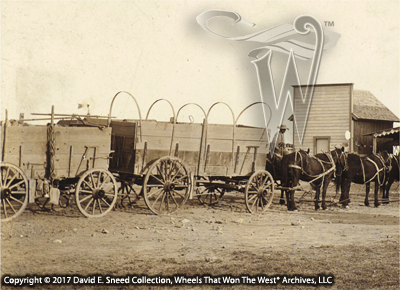America’s early growth was shaped by ahost of transportation routes. From theNational Road in the eastern U.S. to numerous western trails like the Santa Fe,Oregon, California, Chisolm, Goodnight-Loving, Western, and Sedalia, there’s agreat deal of our past that still surrounds the present. Reinforcing America’s tie to legendarytrails, I have a fair amount of early vehicle information that I’ll be unveiling in just a few weeks.
To that point, have you ever reallythought about all it took to go from point A to point B one hundred fifty totwo hundred years ago? Excruciatingsummer heat, violent storms, piercing winters, and very few creature comforts were a regular part of cross-country transportation via equine or oxen. Merciless environments were inescapable, making long-distance trailtravel largely incomprehensible today. Absent the comforts of air conditioning, GPS maps, modern weatherforecasting, convenience stores, and even legal protection, countless wagonsmoved along these corridors throughout the nineteenth century. While there were a lot of differences in thevehicles, one thing they all had in common was that each one was a product of itstime. In other words, every set ofwheels on these trails was subject to the technology available up to andincluding the time of its use. As anexample, this means that a wagon built in the 1860’s typically carriednoticeable differences when compared to one crafted in the 1890’s. Due largely to the driving force ofcompetition, virtually every era was full of advancements and distinctions inthese wooden warriors. As a result,we’re able to use many of the variations as part of an authenticationprocess. The same information is alsocrucial when determining timeframes of manufacture.
Ultimately, the differences in every setof wheels are important points to anyone interested in the real story of thesetransports – and America’s growth. Inthe absence of these details, every old wagon is typically treated the same asanother. In fact, rarely a weekgoes by that I don’t find myself re-explaining this truth. Blanketing every wagon with the same historyis an all-too-common, backward, and wholly inaccurate way to look at thesevehicles. Think about this example forjust a minute. Would you say that apickup truck produced in 1967 is the same as one built in 1997? Clearly, they both have four wheels, atailgate and bed, hood, lights, a transmission, and motor. That makes them the same, right? Of course, the statement is wrong. They’re nowhere close to being the same. It’s the same situation with earlyhorse-drawn wagons.
 |
| Freight wagons on the Santa Fe Trailvaried in a number of ways, including by design, size, and construction features. |
Still, there are deeply ingrained perceptions that persist in lumping all wagons together into one mass heap of indistinguishable identities. Perhaps that’s why few – if any – majorwestern films are known for using period-correct wagons. The presence of wood in the wheels seems to be theonly criteria many use to automatically pigeon-hole a wagon as a member of the1800’s. On one hand, there’s a case tobe made for rolling with the flow and ignoring the lack of accuracy. On the other hand, what is the history wepass along if it’s not accurate?
Over the next few weeks, I’ll befinishing up an extensive study that’s part of a presentation to the Santa FeTrail Association and National Stagecoach and Freight Wagon Association. The conference is open to interestedparties (although there are registration fees) and takes place toward the lastof September. It will include a host ofspeakers covering topics from American Indians, surveys, soldiers, harness,wagons, and more topics related to the history of the Santa Fe Trail.
 |
| This photo of an early freighter shows anumber of transitional design elements. Each helps show how America’s heavy vehicle industry evolved beyond thetraditional Conestoga styling. |
There’s a fair amount of information inmy presentation that won’t be available anywhere else. Some of what I’ll be sharing centers aroundnew discoveries that have not been reported in nearly two centuries. If you haven’t signed up for the event, I’dencourage you to do so. It will be arare opportunity to ride along for a special look at early wagons on the SantaFe Trail as well as these nineteenth century vehicles in general. The timeframes covered will stretch from the1820’s through the 1880’s. The on-line registration ends on September15th so there’s not a lot of time left to make plans to be there.
The only real disclaimer I’ll give isthat the presentation is limited to an hour. In that small amount of time, we’ll be rushing through a lot ofinformation and, undoubtedly, will not cover all there is to know. Even so, it should be a great time to stepback into the past and not only profile more of what these vehicles looked like but a good number of the differences as well.
Looking forward to seeing you there!
Please Note: As with each of our blog writings, all imagery and text is copyrighted with All Rights Reserved. The material may not be broadcast, published, rewritten, or redistributed without prior written permission from David E. Sneed, Wheels That Won The West® Archives, LLC
Please Note: As with each of our blog writings, all imagery and text is copyrighted with All Rights Reserved. The material may not be broadcast, published, rewritten, or redistributed without prior written permission from David E. Sneed, Wheels That Won The West® Archives, LLC